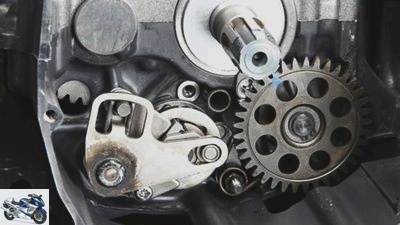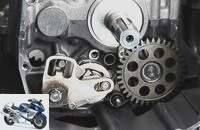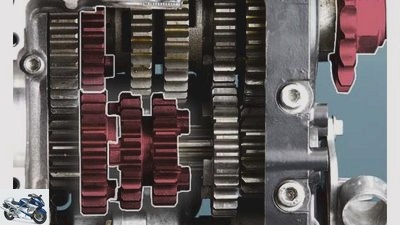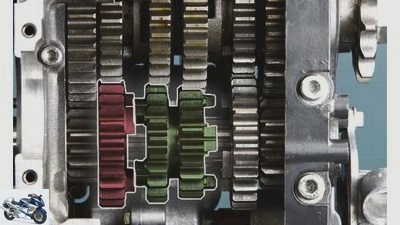Table of contents

fact
counselor
technology & future
Technology: circuit
Technology: circuit
In a hurry
Clear the road, step on the gas and quickly step through the aisles ?? works like clockwork. However, it is hard to imagine that a dozen components can be levered, turned and pushed in fractions of a second when shifting.
Werner Koch
07/03/2009
The automatic switch
In order to move the gear wheels in their position through the rotary movement of the selector shaft, the force on the selector lever is sent to a ratchet mechanism. In the case of the Suzuki GSX-R 600 transmission shown, two pawls engage the teeth of the shift drum and turn the drum in a certain direction, depending on whether the gear is up or down. After the switching process, the pawl together with the transmission lever is returned to its zero position by the hairpin spring. A spring-loaded lock holds the shift drum in its respective position.
The components of the motorcycle dog clutch
Thanks to closer gradations and fewer rotating masses compared to cars, motorcycle transmissions manage without the complex synchronization of the shifting process. The gear shafts on which the gearwheels transmit the drive force in direct engagement via so-called shift claws are correspondingly short.
Buy complete article

Technology: circuit
In a hurry
2 pages) as PDF
€ 2.00
Buy now

fact
Shifting gears: initial situation.
Starting position
The engine power is transmitted from the clutch to the transmission input shaft. The fixed gear, in this case a double gear, is located there and connects the so-called idler gear with the shaft via the shift claws. Idler wheel because it rotates on a needle bearing and has no positive connection with the gear shaft. The opposite gear on the output shaft absorbs the driving force and transmits it to the chain pinion. The interlocking claws are provided with a so-called relief of about three degrees. This causes the ratchet gears to pull together under load. Thus, the shift fork is spared from destructive side forces.
Switching process
Only when upshifting does the shift fork push the double gear to the right and interrupt the power transmission as soon as the claws are no longer engaged. This process takes around seven hundredths of a second for a sporty, brisk gear change. To do this, however, the transmission, namely the shift dogs, must be completely relieved. This happens during normal gear shifting by separating the clutch disks. In racing, the load relief in the drive train is only achieved by briefly turning back the throttle grip. But this only works without consequential damage if the gear is shifted through consistently and changes position at lightning speed. Disadvantage: The load peaks in the transmission are greater.

fact
Gear change: shifting process.
Next gear
After another three hundredths of a second, the shift fork catapulizes the gear into the next higher gear position. It happens in around 70 percent of cases that for a brief moment (around three hundredths of a second) there is claw on claw and the switching process feels correspondingly bulky and hard. Due to the free angle of rotation of the gears, the claws still slip into their position and ensure the power transmission.
The automatic switch
In order to move the gear wheels in their position through the rotary movement of the selector shaft, the force on the selector lever is sent to a ratchet mechanism. In the case of the Suzuki GSX-R 600 transmission shown, two pawls engage the teeth of the shift drum and turn the drum in a certain direction, depending on whether the gear is up or down. After the switching process, the pawl together with the transmission lever is returned to its zero position by the hairpin spring. A spring-loaded lock holds the shift drum in its respective position.
Related articles
-
fact motorcycles Technology: automatic Technology: automatic Automatic transmission Our everyday life is becoming more and more complex, and at the same…
-
counselor technology & future Technology: belt drive technology Belt drive Full automation instead of full employment, just step on the gas instead of…
-
Transmission technology in racing
2snap 22nd pictures Gargolov 1/22 With the motorcycles of the early years with their fuel shift levers, a gear change took what felt like an eternity….
-
Technology: Seamless transmission from the Honda RC 213 V.
2snap Sports & scene Motorsport Technology: Seamless transmission from the Honda RC 213 V. MOTOGP technology seamless gear of the Honda RC 213 V Full…
-
MV Agusta F3 engine: the technology
manufacturer counselor technology & future MV Agusta F3 engine: the technology Technology: MV Agusta F3 engine The engine of the super sports car from MV…
-
Technology: Driving dynamics safety
counselor technology & future Technology: driving dynamics / safety Technology: driving dynamics / safety Subject focus The discussion at the motorcycle…
-
The technology of the chassis and suspension
Bilski counselor technology & future The technology of the chassis and suspension Technology: rear wheel The technology of the chassis and suspension…
-
Yamaha / KTM counselor technology & future Technology background draft Technology background draft 1290 Super Duke R versus Yamaha MT-09 Theory and…
-
Technology Superbike developments
Suzuki 16 pictures archive 1/16 Variable valve control Suzuki GSX-R 1000/2016. archive 2/16 Suzuki engine technology in detail: low speed. archive 3/16…
-
Technology: exhaust gas cleaning
motorcycles Technology: exhaust gas cleaning Technology: exhaust gas cleaning Scourer How clean is the F 650 GS really, asked MOTORRAD in issue 10. Now…